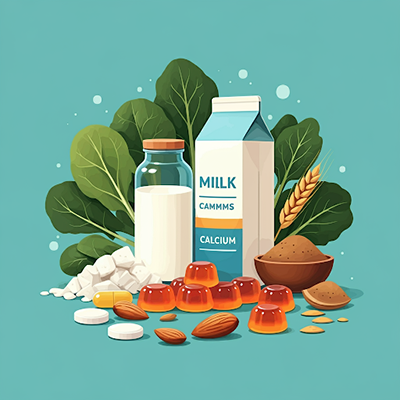Contents

Calcium (Ca) is needed to build and repair bones and teeth. Essential for heart and muscle action. Protects against radioactive strontium 90 intake. Needed for enzyme and blood clotting. Very important during pregnancy and lactation. It helps to speed up all healing processes. Helps maintain the proper balance between sodium, potassium, and magnesium. Needed for treatment of osteoporosis, reducing high blood pressure. Calms heart action and tends to relieve pain.
Sources
The best sources include milk most raw vegetables, especially the green, leafy ones. Sesame seeds are an excellent source since they have such a good calcium-phosphorous ratio. Brewer’s yeast. Other sources include oats, almonds, navy beans, walnuts, millet, and sunflower seeds. A good source will contain lots of calcium and relatively little phosphorous.
Supplements
Calcium citrate is unassumingly absorbed and can be used if you have subdued stomach acid levels, and it is generally the best form to take. However, many products contain lower amounts of elemental (Ca). It should contain 21 percent (Ca) by weight. Calcium carbonate contains forty percent (Ca) but is not easily absorbed. (Refined forms are produced in a laboratory; unrefined forms are derived from limestone or oyster shells.)
Calcium gluconate contains 9 percent but sometimes causes diarrhea and nausea. Calcium lactate contains 13 percent, along with lactic acid from milk. It is more acidic than some of the other supplements. Calcium phosphorous contains 30 percent; but the phosphorous in it tends to lock with the (Ca) and carry it on out of the system.
Do not take calcium phosphorous tablets or powder. Other forms are dolomite, which is calcium and magnesium from dolomitic rock, and bone meal, from ground-up animal bones (an inferior product because they also contain phosphorous). Most unrefined (Ca) products have unacceptably high levels of lead. Citrate is probably best for the lowest lead level and is absorbed the best. Lactate and gluconate powder are useable sources. In the opinion of some, the gluconate formula tastes better than the one with lactate.
Deficiency Symptoms
- Retarded growth
- tooth decay
- rickets
- osteomalacia
- osteoporosis
- irritability
- nervousness
- heart palpitations
- muscle cramps
- insomnia
Needed for Assimilation
- Vitamins A, C, D, and E
- Boron
- Essential fatty acids
- Magnesium
- Manganese
- Phosphorous
- Lysine
Interactions

This mineral interacts with many nutrients, especially vitamin D, K, and magnesium. High dosages of magnesium, zinc, phosphates, protein, sodium, and sugar reduce calcium absorption. Caffeine, alcohol, phosphates, sodium, protein, and sugar increase calcium excretion. (The weightlessness of space travel also does). Antacids containing aluminum increase bone breakdown and excretion of calcium.
Cautions
Too much phosphorous in a meal will lock with calcium, rendering it ineffective. Too much oil at a meal will lock with this mineral, turn it into a kind of soap, and both will go out through the bowels.
Dosage
Calcium (Ca): RDA2/ ODA 2000 mg/ TDA 2000-5000mg. Recommended: 1000 mg daily. During pregnancy and lactation, 1200 mg daily. Especially during pregnancy or lactation, take 1000-1400 mg. Supplements are generally well-tolerated at dosages less than 2000 mg; however, higher dosages may escalate the risk for kidney stones as well as soft-tissue calcification (although neither problem has conclusively been shown to be caused by taking (Ca) supplements).
HEALTH DISCLAIMER: The information on this website is for educational uses only and is not a substitute for professional medical advice. Always consult an authorized healthcare provider for any health concerns before using any herbal or natural remedy. We do not establish, treat, cure, or prevent any disease. Reliance on any material from this website is solely at your own risk. We are not responsible for any adverse effects resulting from the use of information or products mentioned on this website.
REFERENCES
Vance Ferrell, Harold M. Cherne, M.D. 2010. The Natural Remedies Encyclopedia. Altamont : Harvestime Books, 2010. pp. 110. Vol. Seventh.
